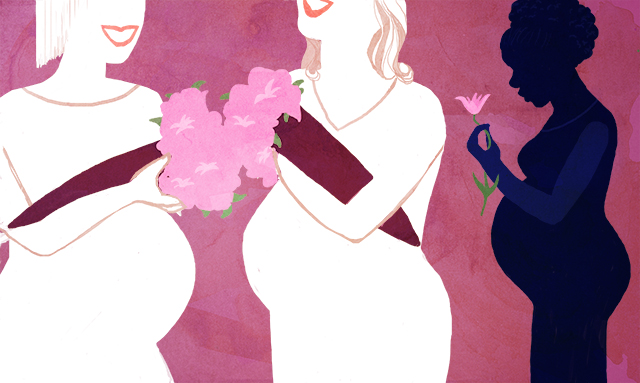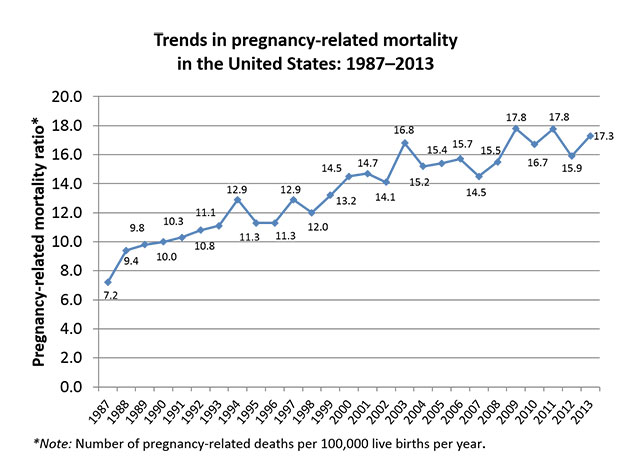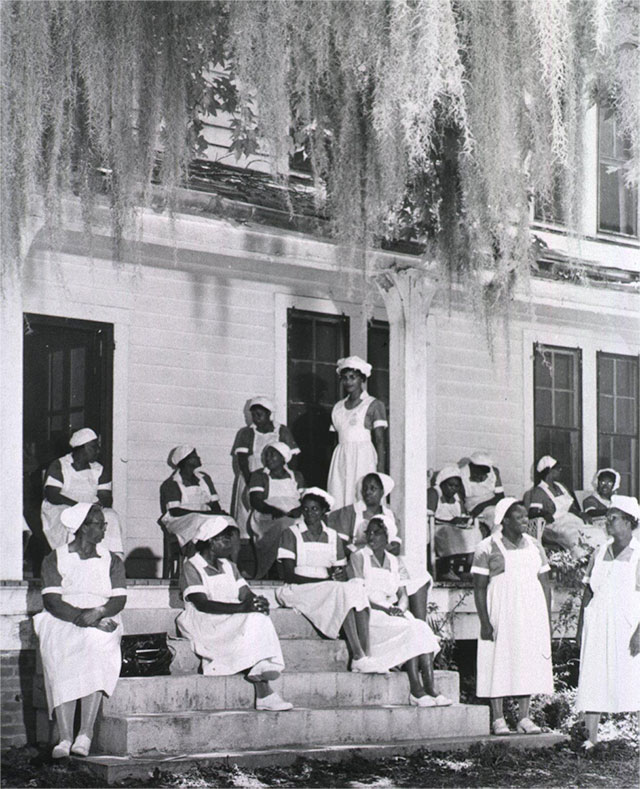
To say that the birth industry is mostly white would be an extreme understatement. Less than 4 percent of registered nurse midwives are African American, around 1 percent are of Asian descent and less than 1 percent are Latina according to a recent survey. A low level of representation is an issue in many industries, but in the birth world it is particularly problematic. The pervasive whiteness of the birth industry leads to culturally incompetent care that fuels the negative outcomes that women of color face both directly and indirectly. Low levels of cultural awareness lead to stereotyping and assumptions that fail to consider Black, Latina, Asian American, Arab American and Indigenous women’s unique circumstances and perpetuate ineffective methods of care. As a result, white values and experiences have interpenetrated the birth world and further isolated women of color.
Black mothers in particular have a maternal mortality rate that is more than four times the national average. According to the Centers for Disease Control (CDC), there is an average of 12.1 deaths per 100,000 live births for white women, 40.4 deaths per 100,000 live births for Black women, and 16.4 deaths per 100,000 live births for “women of other races” (the CDC report does not break this number down further). Meanwhile Black babies have an infant mortality rate that is more than two times the national average.
Despite efforts from the World Health Organization (WHO) to combat maternal and infant mortality, maternal mortality rates in the United States continue to worsen, unlike those in other wealthy countries.

Among the multitude of factors that have created this health crisis, toxic stress and the emotional manifestations of racism are key elements. Women of color are substantially more likely to deal with poverty, face language barriers and have limited access to health care. All of these make it difficult to receive adequate care. These environmental stressors are often overlooked by white birth workers who work with women of color.
This oversight was perfectly illustrated when Ina May Gaskin, a well-known natural birth advocate, answered questions about race and maternal mortality during a Birth Roundup hosted by Texas Birth Networks. After registered nurse Tasha Portley inquired about the connection between race and maternal mortality, Gaskin gave a roundabout answer that ultimately denied the impact of systemic racism on maternal care for mothers of color. Instead of addressing the combination of race and poverty, she spoke to the issues of poor white women, saying: “You couldn’t look at our numbers and have anything useful to say about it because the number of African American women would’ve been rather low. Poverty, we’ve got that covered. We were some of the poorest.” After she danced around the question, Portley informed her that once nutrition, smoking and finances were accounted for, race was a strong influencer of outcomes. In response, however, Gaskin merely emphasized the importance of prayer in managing stress. In reflecting on how unresponsive Gaskin’s comment was, Portley later commented, “We [Black women] are one of the most religious people on the planet.” Gaskin’s icon status has the ability to pass this culturally insensitive rhetoric on to the next generation of white birth workers. As a matter of fact, the room, filled with white birth workers, was unfazed and chuckled in affirmation of Gaskin’s comments.
One Black birth worker speaking out in a sea of whiteness is a sample reflective of the birth industry. The lack of awareness and the cultural insensitivity that was displayed here is symbolic of the experiences of women of color across the nation. White birth workers are often unfamiliar with the consequences of systemic racism and look to class alone as the cause of health disparities. Even when women of color give firsthand accounts of our experiences, the birth industry ignores us.
Clearly, the high mortality rates are much more than a class issue — Black women with advanced degrees are more likely to lose their babies than white women with high school diplomas.
Nikia Lawson is a birth worker of color located in Fort Worth, Texas, where the Birth Roundup took place. According to Lawson, above all else, it is most important to “trust Black women when it comes to their bodies.” Lawson works to fight health disparities in the birth community by educating mothers on pregnancy and postpartum care. “Birth workers of color have found ourselves in a position to really educate and shift the final birth outcomes of the expectant woman, who pretty much looks like us, who have experiences similar to ours — and we primarily understand the situations that our expectant mothers face,” Lawson told Truthout. After hearing Gaskin’s comments, Lawson took to her Facebook page, which is filled with both Black and white birth workers from around the world, to address the importance of collaborative effort in creating change.
What would change look like? For Black women, we need birth workers who understand we exist at the intersection of history, race, gender and reproductive health.
In Texas, where Lawson lives, the maternal mortality rate is not only the highest in the United States, but also the highest in the industrial world. Black women account for 11.4 percent of births in Texas but 28.8 percent of deaths.
Upon speaking to Lawson, it became clear the birth industry was not created with women of color in mind. She explained that the birth industry was established by white men and women, who “researched the impact of birth support [in] Indigenous culture, then brought the concept back to western society and began training women to serve.” Indigenous women and other women of color already had traditional methods for supporting birthing women that the newly trained white midwives drew upon heavily. In the early 1920s when many of these changes in the birth industry began, white women were in a better position to afford birth services outside of the home. As a result, the new developments in the birth industry mostly impacted white women.
The Rise of the Professional (White) Midwife
Birth workers of color have always existed.

Prior to 1921, in the south, Black lay midwives — often known as “granny midwives” — provided medical care to poor and rural pregnant women. The Sheppard-Towner Act of 1921 was an attempt to create a more professional education path for birth workers that reduced mortality. Instead, it resulted in more obstacles for midwives, particularly Black women, to continue their work. Suddenly, a smear campaign portrayed lay midwives as dirty, uneducated and unqualified to handle births. Not unexpectedly, the discrediting of midwives was often rooted in racist ideas. “Filthy and ignorant and not far removed from the jungles of Africa,” were the descriptors used by the director of the Board of Health, Felix Underwood, in 1926 in reference to Black midwives. (Strangely, Underwood himself facilitated midwifery programs.) In other words, racially based preconceptions, in addition to attacks from “professional” obstetrics, played a key part in the downfall of lay midwifery.
The newly emerged professional midwife was portrayed in a pristine white uniform to signify both sterile practices and a lack of individuality. It was apparent that midwives were now regulated followers of modern medicine. Even after training, Black midwives served as a placeholder until enough nurses were trained to assist obstetricians with births.
Midwives were also expected to serve as race gatekeepers during birth. Walter Plecker, a physician, county registrar and later state registrar of [Bureau of] Vital Statistics in Virginia enlisted midwives to “police the women they assisted so that no mixed-race children got the opportunity to ‘pass’ into the white world.” Filling out birth registers became primary concerns, and those who did this “incorrectly” lost their licenses.
Black midwives were placed between two contradicting systems. On one hand, they were supposed to assist in reducing maternal and infant mortality in their communities of origin. On another, they were used within the oppressive system that created these disparities to ensure no racial mixing. As expected, a system that gives high levels of effort to segregation of races has no time for culturally-sensitive care. From the institutionalization of midwifery, all matters of culture would be expected to take a back seat to enforcing systemic oppression. The numbers of Black midwives dwindled, but prior to this, the culture and spiritual nature of midwifery had already receded. The percentage of births attended by midwives in Richmond, Virginia, fell from 41 percent in 1907 to 18 percent in 1922. At the same time, doctor-attended births increased from 59 percent to 82 percent, according to “Maternal Mortality in Richmond: A Preliminary Survey” published in 1923 by C.C. Hudson and M.P. Rucker in the Virginia Medical Monthly. Over time, lay midwives were replaced by white nurses with higher levels of medical training.
Eventually, the industry became overwhelmingly dominated by white birth workers and practices that aligned with whiteness. Moreover, this shift decreased representation of midwives of color in the field and limited women of color’s access to midwives, since they could no longer afford home birth services. Soon the industry shift led to nearly 99 percent of US babies being born in hospitals.
In the face of these changes, what can be done to support birth parents of color in the current moment? “I think the best way to combat the issue of maternal mortality is to continue to educate moms about their options for their childbirth experience,” Lawson said, explaining that many people are unaware that it’s possible to access birth support outside what is offered in the hospital.
However, in the last 30 years, the birth industry has been changing. “Now, birth workers of color are seeking to support marginalized, disadvantaged, disproportionately affected communities that have adverse birth outcomes,” explained Lawson.
Black birth workers and other birth workers of color must not only create spaces to work within their own communities — they must reclaim a tradition that was wiped out by hate-based standardization. Ina May Gaskin’s comments were neither surprising nor unusual — they were the product of an industry that wasn’t established with Black women’s benefit in mind. The birth industry was never intended to serve women of color. It was created to police and reinforce an oppressive system. Acknowledging the whiteness of the birth industry means coming to terms with this fact and finding a way to transform an anti-Black institution.
Media that fights fascism
Truthout is funded almost entirely by readers — that’s why we can speak truth to power and cut against the mainstream narrative. But independent journalists at Truthout face mounting political repression under Trump.
We rely on your support to survive McCarthyist censorship. Please make a tax-deductible one-time or monthly donation.